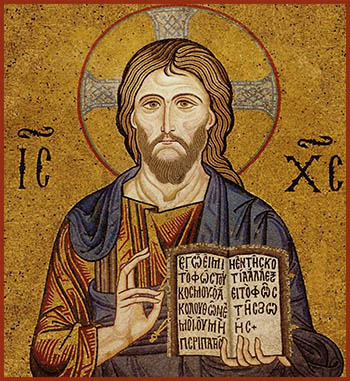
![]()
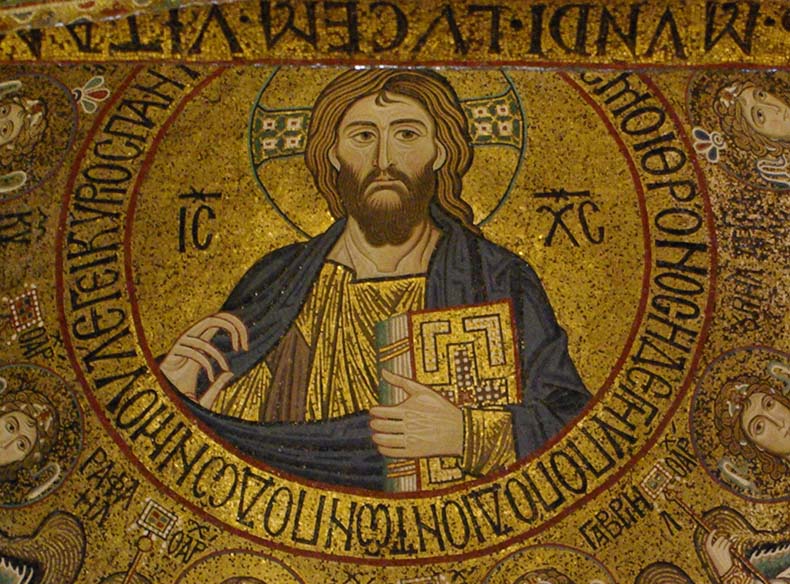
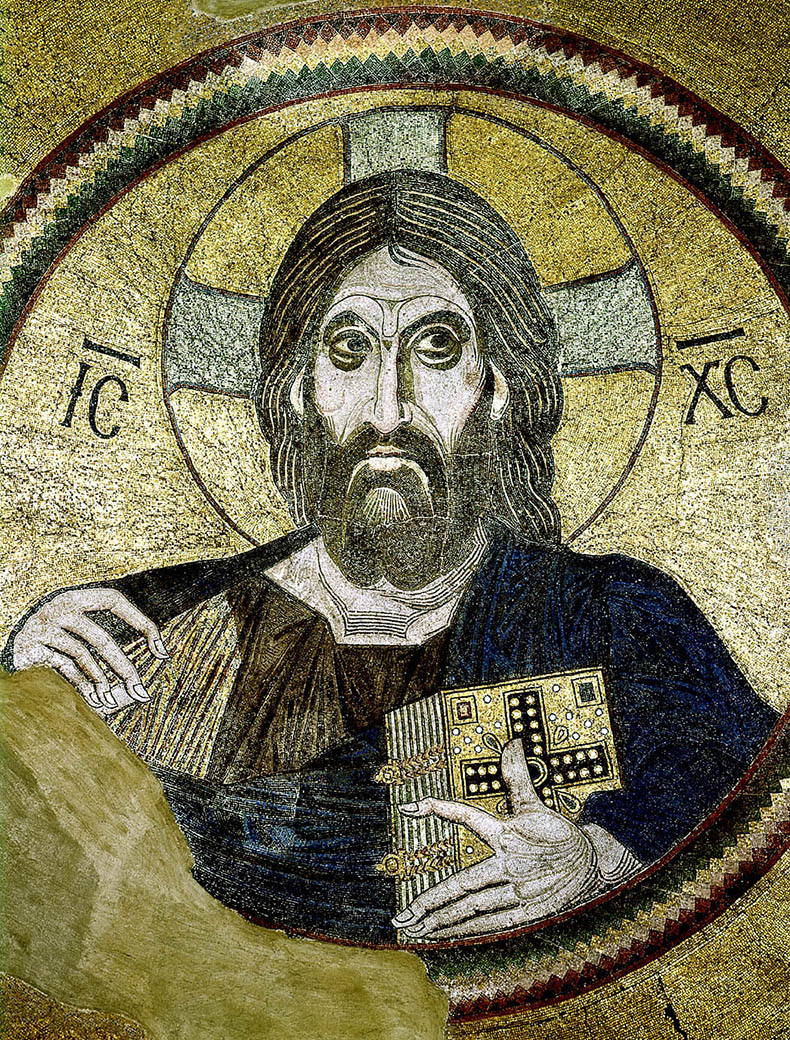
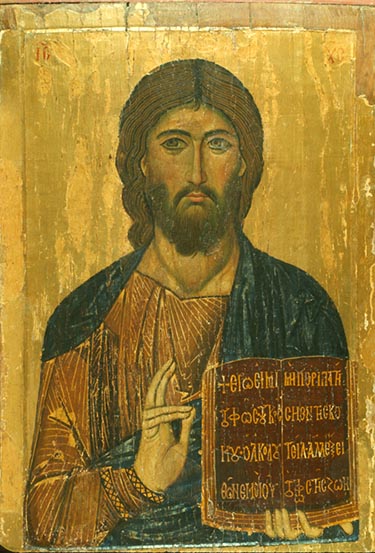
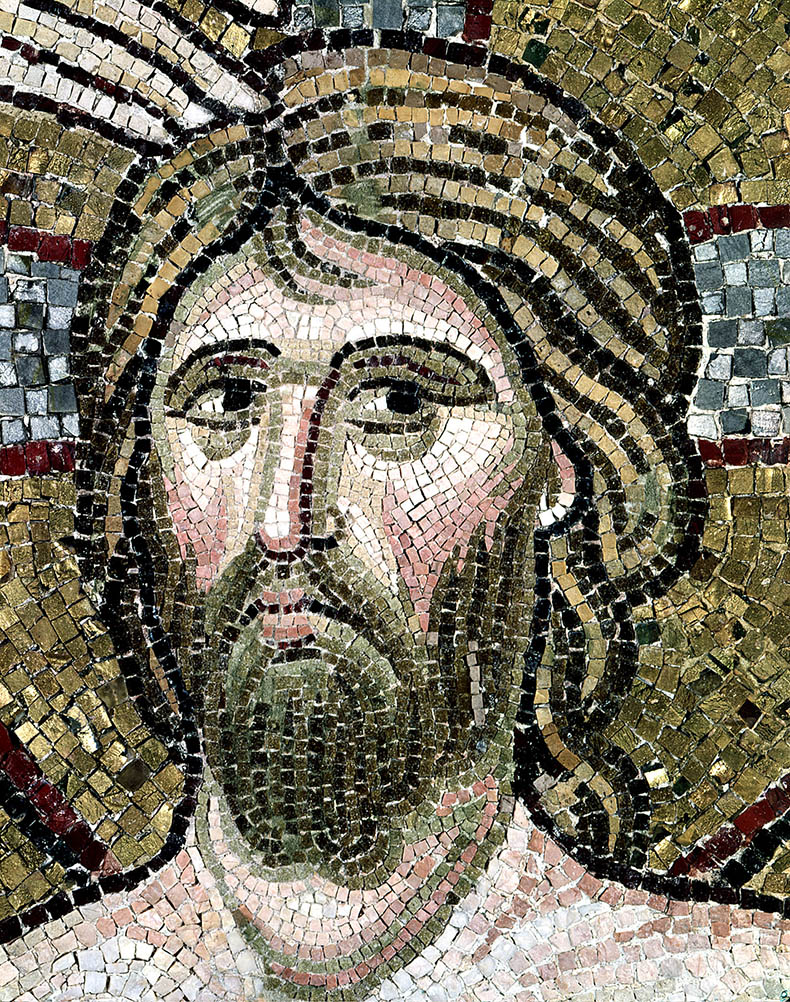

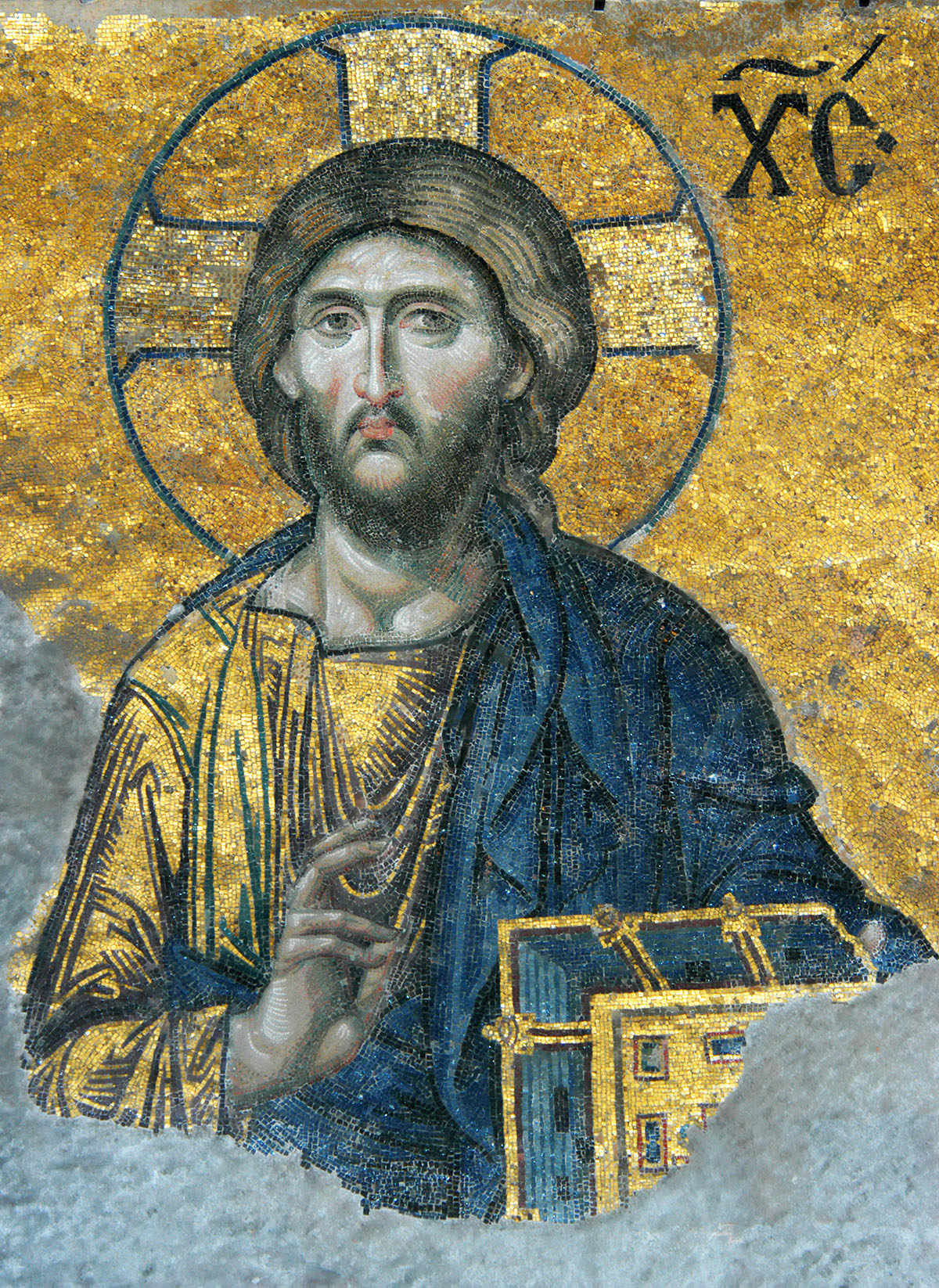 Face Dimensions: Height from the crown of the head to the end. of the beard: 0-770 m. (31 in) Greatest breadth: 0-660 m. (26 in)
Face Dimensions: Height from the crown of the head to the end. of the beard: 0-770 m. (31 in) Greatest breadth: 0-660 m. (26 in)
The size of the unpolished stone tessellae (white, grey, light yellow, and rose) varies from 2X3 mm. to 6X7 mm., that of glass tesserae from 2X3 mm. to 7X9 mm. In some places, in the right eye, for instance, and under the left wing of the nose, are inserted extremely small irregularly shaped tessellae.
The hair: the whole mass of hair is enlivened inside by one row of quite dark coffee-brown glass tessellae. Ivory-black contour marks the extent of the hair round face and neck, also of the head from the upright limb of the cross to His left shoulder. The hair is made of: (1) green-olive glass tessellae of three different warm tones, (2) sage-green glass tessellae | of light cold tone, (3) dark violet translucent glass tessellae, and (4) light ochre and brown-ochre marble tessellae. These ochre hues are used for the lighted parts of the hair. The strongest light falls on the right side, from the parting to the ear. On the left side the hair is in half-shade and, above the forehead, in shade. On this side the locks are outlined with green-olive glass tessellae. On each lock the lighted parts are made of stone-light ochre tessellae and half-shades of light green-olive glass tessellae. The deepness of the colour of the rows outlining. the locks as well as of the rows forming the half-shades varies, but the tesserae in the rows for high lights are uniform because of their composition (stone). Under the left ear the locks are made of darker tone of green-olive glass tessellae; they are outlined with ivory-black and violet glass tessellae, and the lighted part is indicated in brown ochre.
On the left shaded side, the high lights of the locks are in brown ochre; they form shorter rows than on the other side of the head, and among them are rows of sage-green glass tessellae forming the tone next to the high lights, whilst dark violet ones form the deepest tones.
The original plaster was covered with a layer of wax at the time of the preparation of the panel and was left at some places without tessellae. Where the wax has fallen, an olive-green is seen painted over the paler earth-green of the original fresco.
A narrow ragged fissure in the plaster at the parting of the hair suggests the joining of the earlier layer of plaster with the new.
Forehead: retreating part is in olive-grey of three tones on the right side. Same colours are used on the left side, but in a more complicated way. The succession of colours of cubes from the outline of the hair towards the high lights of the forehead is as follows: two rows of olive-brown, a row of lighter olive with a few olive-brown cubes, three rows where olive alternates with lighter grey-olive, one row of olive-grey of lighter tone alternating with rose, a row of very light silver-olive ending wedge-like towards the middle of the forehead, two long rows and a short one of ochre. The rest of the forehead is composed of light sand-grey and whitish-grey marble tessellae lined with pale ochre warmed by light rose. Short blade-like lines of white tessellae express the high lights above the brows, nose, and the frontal prominences.
The shadow above the bridge of the nose consists of four curves of olive-grey cubes. The lower row is of a deeper tone. Into these lines the lightest olive rows above the eyebrows entering this shadow mingle in similar forms. Above the brows the superciliary arches are marked by two olive rows: darker in the middle and of a lighter tone on both sides.
Eyebrows: two rows of olive-green glass tessellae, in two tones, the darker below the lighter.
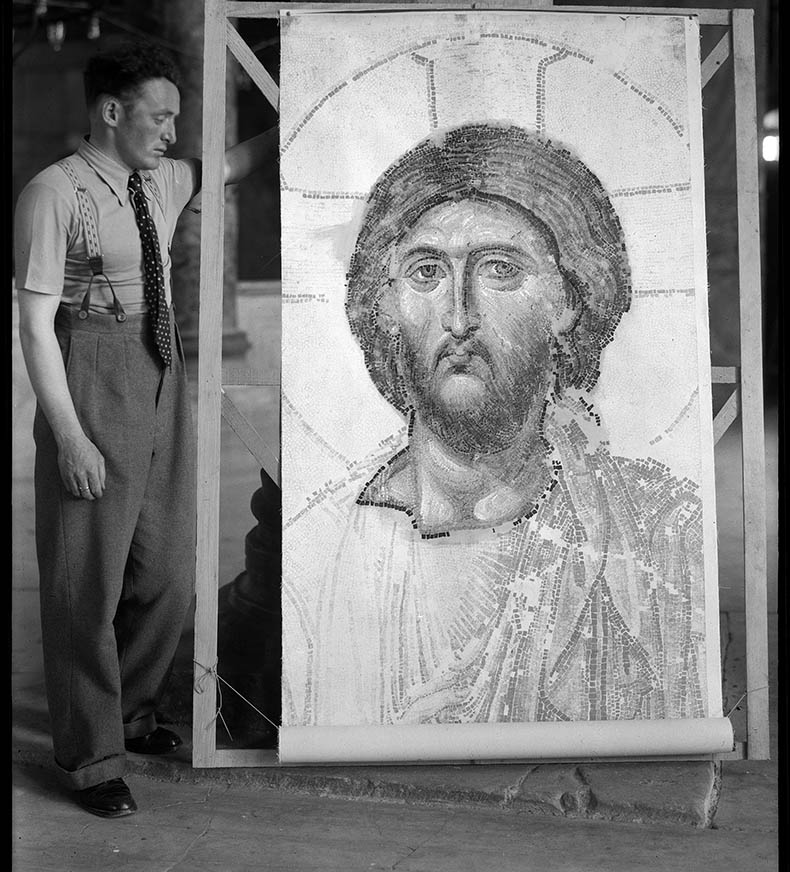 That's Alvin Green above with a replica of the Deesis he created. First an impression was made of the mosaic and then he hand colored every mosaic cube. In the process of doing this he wrote these technical notes which were published under Whittemore's name.
That's Alvin Green above with a replica of the Deesis he created. First an impression was made of the mosaic and then he hand colored every mosaic cube. In the process of doing this he wrote these technical notes which were published under Whittemore's name.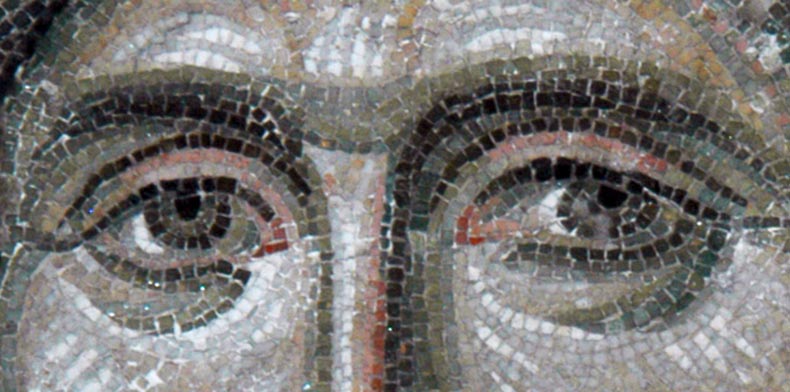 Eyes: right upper lid: under the brow is a row of greenish-olive tesserae broadening to three rows at the right, below that is the outline of the lid in olive-brown and two rows representing the lid: the upper row is in rose shading towards light-olive grey near the nose, the lower row is yellowish-sand-grey at the right, yellowish-rosy-white in the middle, and rose near the nose. Between the upper row and the outline is a short row of olive of a darker tone.
Eyes: right upper lid: under the brow is a row of greenish-olive tesserae broadening to three rows at the right, below that is the outline of the lid in olive-brown and two rows representing the lid: the upper row is in rose shading towards light-olive grey near the nose, the lower row is yellowish-sand-grey at the right, yellowish-rosy-white in the middle, and rose near the nose. Between the upper row and the outline is a short row of olive of a darker tone.
Left upper lid: under the brow is a row of greenish-olive tessellae broadening to three rows at the left, below that is the outline of the upper lid in olive-brown and two rows representing the lid: the upper row is in rose shading towards a warm tone of olive near the nose, the lower row is yellowish-rosy-white in the middle and light olive-grey at either end.
The upper eyelashes are, in the centre, dark brown, almost black, and at the ends olive-brown (of a little lighter hue at the outer end).
The outline of the lower lids is in green-olive — darker towards the lachrymal gland of the right eye, lighter towards that of the left eye. The hollows under the lower lids are made of light grey, olive of two tones, and palest ochre tessellae.
The right pupil is formed by a semicircular dark brown, almost black cube with a narrow cube of the same colour above. The left pupil is also semicircular and is of the same colour; its height is, however, smaller than in the right eye. The space between this pupil and the inner row of the iris is filled with plaster painted grey and is the original fresco.
Irides: the inner semicircle is olive-grey, the outer semicircle olive-brown, darkest at the outer end, lighter near the lachrymal of the left eye. The iris of the left eye is damaged: four tessellae are missing, but the fresco remains and the loss is minimized.
Eyeballs: Right eye: the lighted side is of light grey-green tessellae and the high light of white tessellae: the shaded side is of two green-olive tones, darkest near the lachrymal gland. Between the eyeball and the upper eyelash, above the lachrymal, is a short row of rose tessellae. One row of the same colour is set above the outline of the lower lid. The eyeball of the left eye has on its lighted side a high light almost white surrounded from below by a row of ochre. A short row of rose tessellae is near the
lachrymal; the rest of the eyeball is green-olive. Three rose tesserae are placed between the eyeball and upper lashes. a
The lachrymal glands consist of three dark rose tessellae above which are two of lighter rose'in the right eye. Three rose tessellae and one darker below them mark the gland of the left eye.
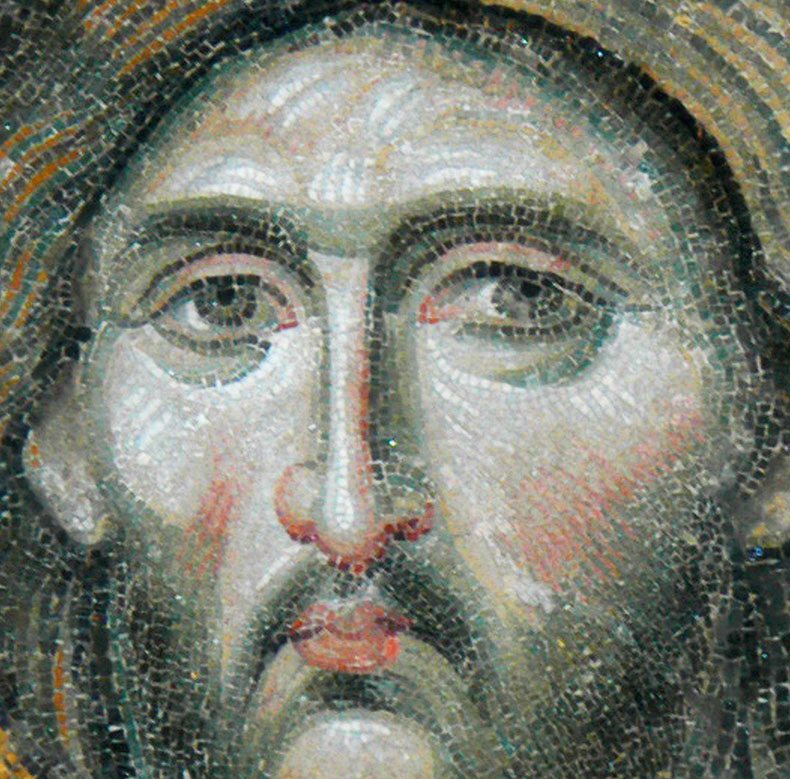 Nose: the high light is one line of almost white marble tesserae ending at the tip in two short curving rows of seven tessellae.
Nose: the high light is one line of almost white marble tesserae ending at the tip in two short curving rows of seven tessellae.
It is interesting to compare this treatment with seven cubes with the earlier use of one large tessella of the same shape.
To the right the olive-brown outline is separated from the high light by a row of cubes varying in tone through light grey, light olive-green, light olive-grey glass, and pale rose; to the left of the high light three tones of rose deepen to the olive-brown outline. The tip of the nose is in brown- red outline, followed upwards by rows of dark rose, light rose, very light yellowish-rose. The right wing has a dark rose outline followed by a lighter rose and yellowish-white-rose with greyish-white. The left wing is of olive, greyish-olive, yellowish-olive to a dark rose outline. Only the left nostril is seen in one cube of olive-brown.
Cheeks: the lighted parts of the cheeks are made of light grey marble tesserae and of light ochre of the same tone. Near the nose the grey tones deepen.
The blush on the left cheek is made of rose tessellae in three tones, set aslant in short, narrow blades, with their upper ends penetrating in wedges into the rows of ochre tessellae, their lower ends entering the sage-green and green-olive of the shaded parts of the cheek. The flush covers the whole cheek in soft intermingling of lights and shades.
On the right cheek the flush covers only the right part of the cheek-bone. It is of rows of light ochre and light rose tessellae; the ochre tesserae are larger, the rose are less than half as wide as the ochre. Towards the lower part of the flush the ochre tessellae are only at the outer side, the inner side being alternating lines of dark and light rose which, with their lower ends, enter in wedges the sage-green shade of the cheeks. The lighted part of the cheeks is made of grey tessellae of two tones.
White high lights are put on both sides of the eye-socket; on the inner side the high light starts from the lachrymal gland; a little below it there is another high light separated from the former by one row of light grey tessellae. On the lighted part of the right cheek-bone, four short rows of high lights are alternating with rows of light grey tessellae. There is a high light passing down from the right wing of the nose and another, shorter, downwards from the nostril.
Ears: remains of the right ear, near the hair, are a row of light olive tesserae - and two rows of ochre and several rose cubes. The left ear has an exterior row of light olive-green tessellae and an inner row of light ochre; in the upper part a row of five rose tessellae is preserved and, near it, separated by one row of dark olive, is a vertical row of dark red-violet glass tesserae with dull surface. Mere fragments of the ears remain.
Mouth: the lips are in three shades of warm rose, the outer corners of the mouth on the left side are of three dark red tessellae and one below lighter; and, on the right, of two dark red tessellae and one green-olive cube below. The shaded corners of the lips blend on both sides with the warm green-olive shades under the moustache.
The mouth is small in relation to the other features.
Moustache: olive-brown and, for the lighted parts, olive and grey-olive. The right side of the moustache is lighter than the left.
Beard: the beard is worked in very small glass tessellae. The locks are outlined with dark green-olive rows; the space between these rows is filled with tessellae of the same colour but lighter in tone. The shadows are short, blade-like lines of dark violet translucent glass.
Chin: the chin is in green-olive and olive tones deepened by two rows of dark brown-olive tessellae. The upper part of the chin is of cold light grey and warm light ochre tessellae. There is here a white-grey and an almost white high light extending downwards from a horizontal crescent of the same colour in three strokes. On the lower part of the chin are ochre tessellae of a slightly darker tone than those on the upper part and also mid-rose cubes. The sharp ends of these rows of warm tones play and interchange with the rows of cold tones of the beard.
The face and beard are drawn in sharp, closely placed lines, interweaving colours and tones very much as the tempera painters worked with fine pointed brush-strokes. It is interesting to note that three tones of each colour are usual.
Ears: remains of the right ear, near the hair, are a row of light olive tesserae - and two rows of ochre and several rose cubes. The left ear has an exterior row of light olive-green tessellae and an inner row of light ochre; in the upper part a row of five rose tessellae is preserved and, near it, separated by one row of dark olive, is a vertical row of dark red-violet glass tesserae with dull surface. Mere fragments of the ears remain.
Mouth: the lips are in three shades of warm rose, the outer corners of the mouth on the left side are of three dark red tessellae and one below lighter; and, on the right, of two dark red tessellae and one green-olive cube below. The shaded corners of the lips blend on both sides with the warm green-olive shades under the moustache. The mouth is small in relation to the other features.
Moustache: olive-brown and, for the lighted parts, olive and grey-olive. The right side of the moustache is lighter than the left.
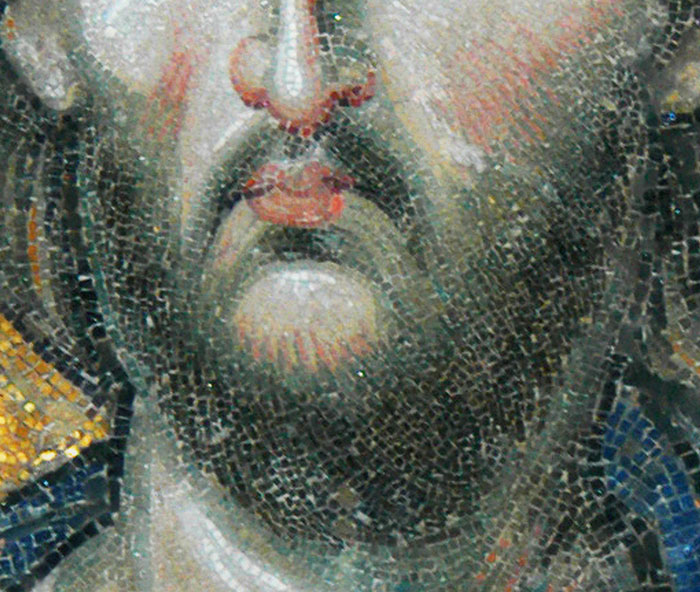 Beard: the beard is worked in very small glass tessellae. The locks are outlined with dark green-olive rows; the space between these rows is filled with tessellae of the same colour but lighter in tone. The shadows are short, blade-like lines of dark violet translucent glass.
Beard: the beard is worked in very small glass tessellae. The locks are outlined with dark green-olive rows; the space between these rows is filled with tessellae of the same colour but lighter in tone. The shadows are short, blade-like lines of dark violet translucent glass.
Chin: the chin is in green-olive and olive tones deepened by two rows of dark brown-olive tessellae. The upper part of the chin is of cold light grey and warm light ochre tessellae. There is here a white-grey and an almost white high light extending downwards from a horizontal crescent of the same colour in three strokes. On the lower part of the chin are ochre tessellae of a slightly darker tone than those on the upper part and also mid-rose cubes. The sharp ends of these rows of warm tones play and interchange with the rows of cold tones of the beard. The face and beard are drawn in sharp, closely placed lines, interweaving colours and tones very much as the tempera painters worked with fine pointed brush-strokes. It is interesting to note that three tones of each colour are usual.
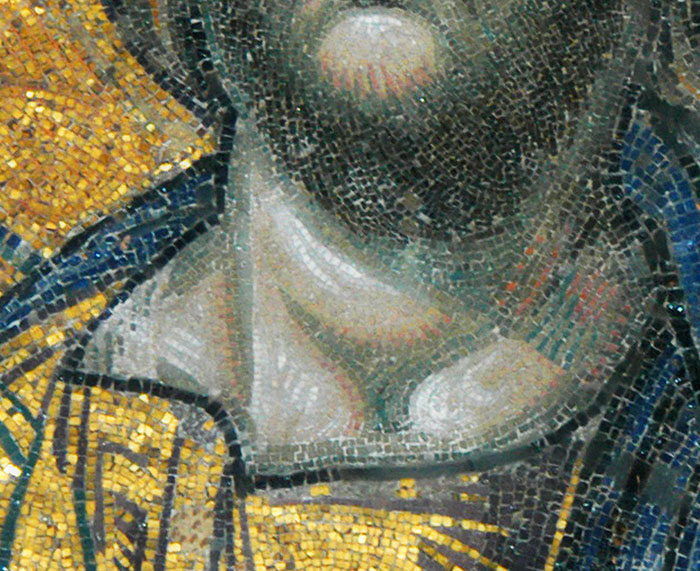 Neck: the shade cast by the beard is in olive tessellae of three tones and green- blue of a cold tone. The left shaded side of the neck is drawn with slanting rows of olive-green tessellae which in one row are in alternation with dark rose, whereas two rows lower there is one row of dark rose of two tones set between the olive-green rows. The shade is separated in two parts by a row of dark olive-green representing the strong muscle of the neck. Below this line the shade is made of slanting rows of warm light olive tessellae, alternating with cold green-blue; rows of dark rose are set between the outer olive rows.
Neck: the shade cast by the beard is in olive tessellae of three tones and green- blue of a cold tone. The left shaded side of the neck is drawn with slanting rows of olive-green tessellae which in one row are in alternation with dark rose, whereas two rows lower there is one row of dark rose of two tones set between the olive-green rows. The shade is separated in two parts by a row of dark olive-green representing the strong muscle of the neck. Below this line the shade is made of slanting rows of warm light olive tessellae, alternating with cold green-blue; rows of dark rose are set between the outer olive rows.
The rose tessellae convey the reflected light into the shadows.
A row of large black-blue tessellae separates the neck from the vestment. Above it are set two rows of olive-green tessellae alternating with rose, lighter in the lower row and darker in the upper. The shade below the pit of the neck is of the same olive tones as under the beard. Along the opening of the collar of the chiton the lower, lighted part of the neck is of three olive rows of which the lowest is also the darkest. The half-shades on the right side of the neck are made of light olive tessellae in two tones; in the second row the olive tessellae of middle tone alternate with rose. The half-shades on the right shoulder, below the neck-line of the chiton, are of olive of the same tone.
The lighted part of the neck is of semicircular rows of pale green and light ochre tesellae of two tones of the palest rose. In this same area are two white high lights: two white lines separated by two white-grey lines; thus the grey is lightened, making one high light. In the transition into the shade, under the beard, pale green cubes alternate with light olive. In the lower lighted part of the neck, on the left at the transition into half-shade, pale ochre tessellae alternate with rose. Adjacent to them is a row of palest rose tessellae. On the right side, along the shaded line to the right, the ochre tessellae alcernate also with rose. There are white high lights in the shape of crescents to the right, and small strokes to the left.
The part of the right shoulder in the sharp angle formed by a fold of the chiton is drawn in vertical alternating lines of mid-olive and white tesserae on the left, and of white-grey and white on the right. The light triangle near the neck is made of slanting rows of light grey tessellae of two tones and of one vertical line of pale rose. This has three high lights in slanting strokes. Again the three rows are not separate high lights but one lightening of the grey.
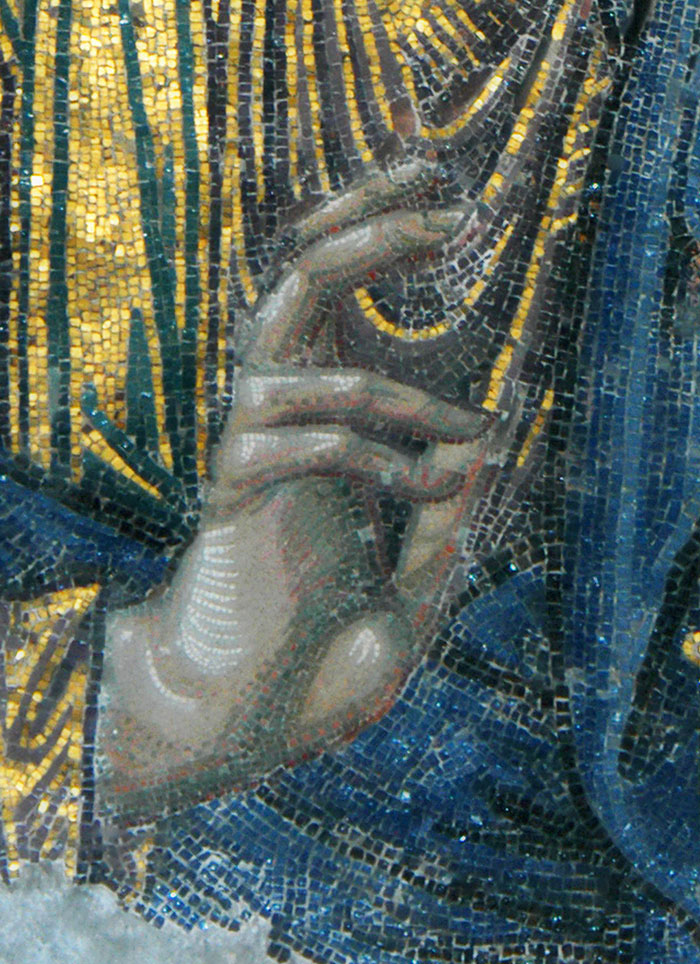 Hands: Right hand: along the outer contour of the fingers along the palm near the thumb, on the outer part of the thumb itself, and along the inner contour of the hand downwards are dark fire-red glass tessellae of two tones, one more red than the other, and of different size and shape. An occasional brick-red tessella is in the dark red line; two such tesseilae are particularly evident in the two lines of the middle joint of the third finger. One sealing-wax-red tessella is set above the middle finger. On the outline of the wrist at the base of the thumb red-violet tessellae alternate with brick-red. The shaded side of the fingers above the red-violet line is of one row of olive-green tessellae, above which are set lines of rose tesserae of medium tone. On the upper part of the external outline of the fingers is a row of sage-green glass tessellae. The lighted surface of the joints is made of light grey, light rose, and light ochre tessellae. The transition to the shaded side of the joints is in two alternating tones of olive and alternating light olive and light rose tessellae.
Hands: Right hand: along the outer contour of the fingers along the palm near the thumb, on the outer part of the thumb itself, and along the inner contour of the hand downwards are dark fire-red glass tessellae of two tones, one more red than the other, and of different size and shape. An occasional brick-red tessella is in the dark red line; two such tesseilae are particularly evident in the two lines of the middle joint of the third finger. One sealing-wax-red tessella is set above the middle finger. On the outline of the wrist at the base of the thumb red-violet tessellae alternate with brick-red. The shaded side of the fingers above the red-violet line is of one row of olive-green tessellae, above which are set lines of rose tesserae of medium tone. On the upper part of the external outline of the fingers is a row of sage-green glass tessellae. The lighted surface of the joints is made of light grey, light rose, and light ochre tessellae. The transition to the shaded side of the joints is in two alternating tones of olive and alternating light olive and light rose tessellae.
The high lights are ivory-white.
The right shaded part of the palm near the thumb is a row of dark olive-green tessellae; between this row and the purple-red outer contour is set a row of deeper olive, wedge-like. The middle part of the palm is of alternating slanting rows of light olive-green tessellae of warm and cold tones. The transition into the lighted part of the palm is in dark rose tessellae near the shade and in light rose near the lighted part. The sharp ends of these last rows penetrate into the light ochre rows of the lighted part of the palm. The twelve ivory-white lines giving the area of light on the palm curve inwards and mingle with the pale grey and ochre tessellae in a sensitive feeling for the oneness of form and colour. The shade at the base of the thumb is of darker olive-green and light olive tessellae alternating with the light and dark rose tessellae. The ball of the thumb is expressed by an oval of pale grey tessellae shadowed with ochre with high light of ivory-white.
The nails: the nail of the first finger is outlined at its sides by three light olive and below by two dark olive-green tessellae. Inside, the nail is drawn by a lower line of light ochre, a middle line of light yellowish-grey, and a high light on the upper part consisting of three ivory-white tesserae. The right tessella of this high light is the largest, the left is the smallest. On the middle finger the nail is outlined in two tones of olive-green at the side and by sage-green at the top. In the central part the surface of the nail is pale ochre, the high light has the shape of a sharp angle made of ivory-white. The nails of the fourth and fifth fingers have an outline of rose tesserae, the surface of the nail being filled with light sage-green cubes. On these two nails there are no high lights.
Left hand: of the left hand only the top of the thumb remains. The thumb is outlined in light olive with a dark red curve showing the shadow. Short curved lines fill the area, three palest pink, one pale ochre, two deeper rose.
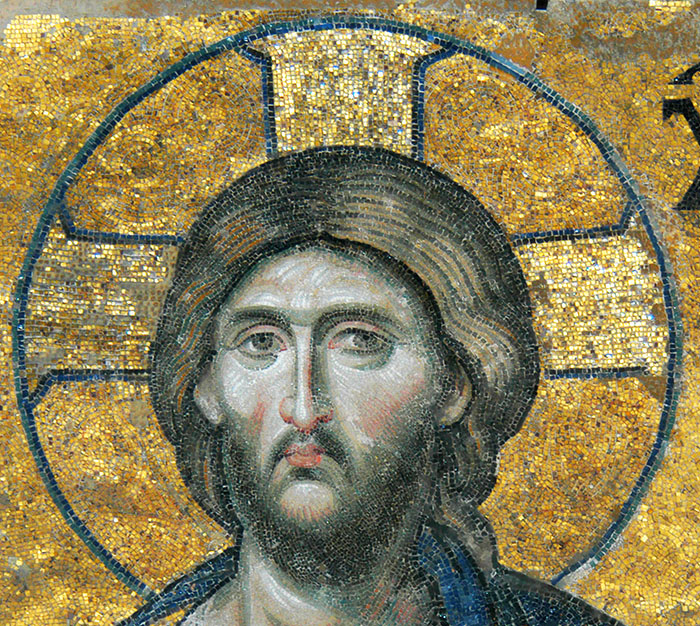 Nimbus: Diameter: 1-13 m. (45 in) The ground is gold formed by tessellae of dark amber and translucent pale green glass upon which the gold leaf is laid, with a covering sheath of glass. A small quantity of silver tessellae is used in the upper right part and under the right limb of the cross.. The outline of the nimbus is a double row of glass tessellae, of which the outer is light terre-verte and the inner soft ultramarine. The outline of the splayed cross is a double row of glass tessellae of soft ultramarine blue outside and dark olive-green within. In the lateral limb of the cross, the cubes are set in horizontal rows with their surface making an angle of approximately 30° with the vertical plane. This angle is greater in the left limb than in the right. The gold tessellae in the upright limb are set at a similar angle though in vertical lines surmounted by four arched lines following the line of the nimbus within the splayed ends of the cross. The average distance between tessellae in the side limbs is 0-5 mm.-1 mm. The interstices between the rows in the lateral limbs and the interstices between the vertical rows in the upper limb are a little wider. Plaster fills the vertical interstices to the middle of the depth of the tessellae. Within the nimbus strong colors in fresco, earth-reds and yellow, are everywhere visible. The left lower quarter of the nimbus is a particularly fine example of the floral pattern in red upon an ochre ground. In the ground of the nimbus, between the limbs of the cross, the space separating the tessellae reaches 4 mm; the plaster fresco fills the interstices almost to the upper surface of the tessellae.
Nimbus: Diameter: 1-13 m. (45 in) The ground is gold formed by tessellae of dark amber and translucent pale green glass upon which the gold leaf is laid, with a covering sheath of glass. A small quantity of silver tessellae is used in the upper right part and under the right limb of the cross.. The outline of the nimbus is a double row of glass tessellae, of which the outer is light terre-verte and the inner soft ultramarine. The outline of the splayed cross is a double row of glass tessellae of soft ultramarine blue outside and dark olive-green within. In the lateral limb of the cross, the cubes are set in horizontal rows with their surface making an angle of approximately 30° with the vertical plane. This angle is greater in the left limb than in the right. The gold tessellae in the upright limb are set at a similar angle though in vertical lines surmounted by four arched lines following the line of the nimbus within the splayed ends of the cross. The average distance between tessellae in the side limbs is 0-5 mm.-1 mm. The interstices between the rows in the lateral limbs and the interstices between the vertical rows in the upper limb are a little wider. Plaster fills the vertical interstices to the middle of the depth of the tessellae. Within the nimbus strong colors in fresco, earth-reds and yellow, are everywhere visible. The left lower quarter of the nimbus is a particularly fine example of the floral pattern in red upon an ochre ground. In the ground of the nimbus, between the limbs of the cross, the space separating the tessellae reaches 4 mm; the plaster fresco fills the interstices almost to the upper surface of the tessellae.
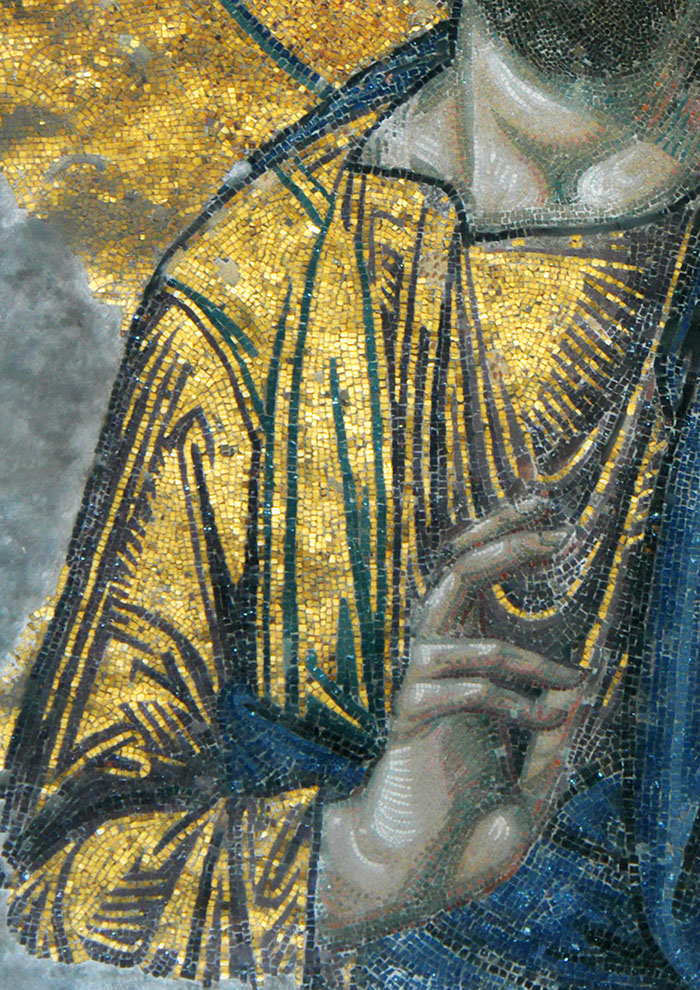 Chiton: The chiton is in greenish-gold thread with folds of violet-red in three opaque tones; the deepest is amethyst, the lightest ash-rose-violet. The clave is of the same gold as the background with almost straight lines of bluish-green tessellae in three tones drawing the long lines of the sharp folds. The craftsmanship in confident design of falling folds and creases in this garment is masterly.
Chiton: The chiton is in greenish-gold thread with folds of violet-red in three opaque tones; the deepest is amethyst, the lightest ash-rose-violet. The clave is of the same gold as the background with almost straight lines of bluish-green tessellae in three tones drawing the long lines of the sharp folds. The craftsmanship in confident design of falling folds and creases in this garment is masterly.
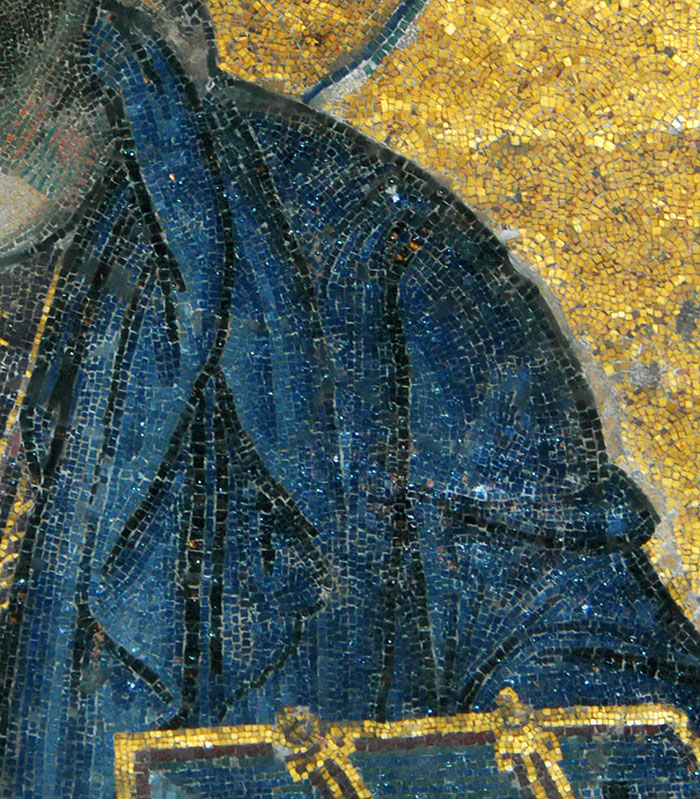 Himation: The general colour of the himation is lapis blue. The shades are of large, 12 X 20 mm. black-blue tessellae. The high lights — in tessellae of varying size — are light blue. The folds are modelled by three tones of lapis blue and one tone of black-blue. Middle tones predominate. The contour of the lower part of the right forearm is outlined against the patterned background by three rows of gold tessellae. All tessellae are of glass. They are set closely and rather carefully; the widest interstices are between the black-blue cubes and reach 4 mm. The soft blue-grey of the fresco setting-ground is everywhere apparent in the interstices.
Himation: The general colour of the himation is lapis blue. The shades are of large, 12 X 20 mm. black-blue tessellae. The high lights — in tessellae of varying size — are light blue. The folds are modelled by three tones of lapis blue and one tone of black-blue. Middle tones predominate. The contour of the lower part of the right forearm is outlined against the patterned background by three rows of gold tessellae. All tessellae are of glass. They are set closely and rather carefully; the widest interstices are between the black-blue cubes and reach 4 mm. The soft blue-grey of the fresco setting-ground is everywhere apparent in the interstices.
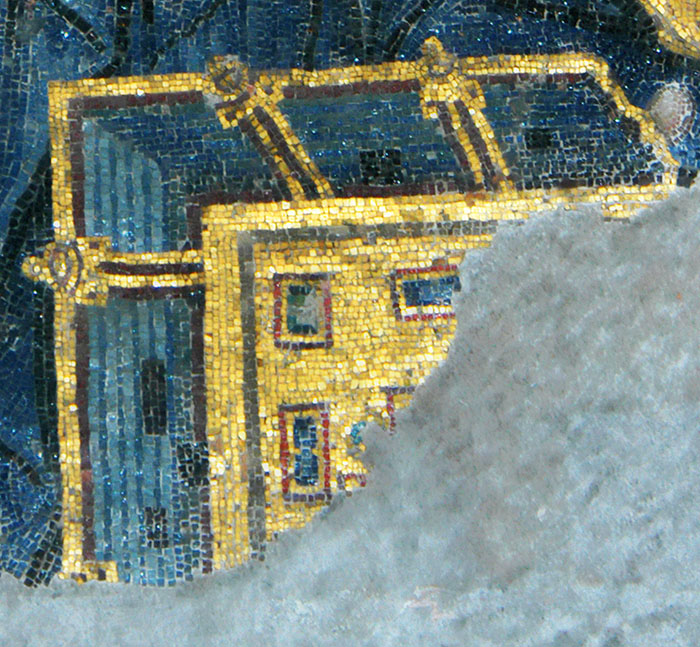 The Book of the Gospels: The front of the cover is gold, outlined by a row of large red-violet tessellae. Between the right upper clasp and the back of the cover this outline gives place to a row of darkest red-violet tessellae. Framing the jewels are two rows of light green-olive tessellae parallel to the vertical and horizontal edges of the cover. Only a part of the central design, probably a cross, remains. It is composed of a row of brick-red and light violet tessellae. Of the pear-shaped precious stone set into an angle of the cross at its centre, there remain but four emerald-green tessellae. All other The Book of jewels set around this central motive are represented framed by one row of gold tessellae surrounded by the sealing-wax-red and red-violet cubes; the middle and the lower lateral jewels are held with two claws, each of which is made of one gold tessella. These frames of the lateral jewels have sealing-wax-red vertical lines and red-purple horizontal lines. The order of colouring is reversed in the remaining jewel frame. Of the upper, lateral jewel are preserved four dark green tessellae on its horizontal side. Below the upper row are two green tessellae; the left one is of a cold tone and the right one warm. Below them is one tessella of cold green tone. The lower lateral jewel and the upper jewel in the centre are of light blue tessellae framed by a row of darker blue cubes. The flexibility of the back of the cover is shown by two wavy rows of gold tessellae. From the back cover are visible, above and from the side, three rows of gold tessellae lined on the inside by a row of dark plum-red tessellae.
The Book of the Gospels: The front of the cover is gold, outlined by a row of large red-violet tessellae. Between the right upper clasp and the back of the cover this outline gives place to a row of darkest red-violet tessellae. Framing the jewels are two rows of light green-olive tessellae parallel to the vertical and horizontal edges of the cover. Only a part of the central design, probably a cross, remains. It is composed of a row of brick-red and light violet tessellae. Of the pear-shaped precious stone set into an angle of the cross at its centre, there remain but four emerald-green tessellae. All other The Book of jewels set around this central motive are represented framed by one row of gold tessellae surrounded by the sealing-wax-red and red-violet cubes; the middle and the lower lateral jewels are held with two claws, each of which is made of one gold tessella. These frames of the lateral jewels have sealing-wax-red vertical lines and red-purple horizontal lines. The order of colouring is reversed in the remaining jewel frame. Of the upper, lateral jewel are preserved four dark green tessellae on its horizontal side. Below the upper row are two green tessellae; the left one is of a cold tone and the right one warm. Below them is one tessella of cold green tone. The lower lateral jewel and the upper jewel in the centre are of light blue tessellae framed by a row of darker blue cubes. The flexibility of the back of the cover is shown by two wavy rows of gold tessellae. From the back cover are visible, above and from the side, three rows of gold tessellae lined on the inside by a row of dark plum-red tessellae.
The clasps are of gold with single lines of dark plum-red tessellae; in the oval, at the end of each clasp, is set a single oval line of pale mauve tesserae surrounding a centre of gold.
The leaves of the book are shown at the left lighted side in lines of light blue tessellae alternating with lines of slightly darker. blue. Next to the framing of the front part of the cover is a double line of light dull-green tessellae. At the top, leaves are shown by middle-blue and grayish-blue tessellae, shaded by darker blue.
The visible ends of book-markers are black-blue, but those protruding from the vertical edges of leaves receiving light are shown in rectangles of red-violet.
Fragment of the Throne: This fragment is roughly 30 cm. wide and 60 cm. high. The ground is gold with green-olive tessellae forming one row above and five to the left. These rows are the beginning of the receding plane of the base; adjacent to these lines on the frontal plane is a double row of dark violet tesserae. The jewel in the centre is of cobalt-blue, rectangular in shape. It is in a gold setting of one row of tessellae with four claws. Around it there is an oval brick-red background in a gold setting suggesting four prongs around which is drawn a row of dark olive-green glass tessellae on the right side, changing into dark violet on the left side. The colour and arrangement of the setting-bed give undoubted proof of the shape of this jewel, though the lower part including two setting-claws is lost. Next are fragments of three other jewels formed by green tessellae in two tones, the darkest surrounding the gems. The jewels are in a setting made of one row of gold tessellae, with four prongs of one gold cube each. Around the setting there is a row of dark olive-green tessellae on the right and upper sides and of dark violet on the left shaded side.
Above the right upper jewel is preserved a large white round stone representing a pearl.
This description was written by Alvin A. Green (Alvin is shown above)
FROM THE MOSAICS OF HAGIA SOPHIA AT ISTANBUL
FOURTH PRELIMINARY REPORT - WORK DONE IN 1934-1938
The Deesis Panel of the South Gallery
by Thomas Whittemore
1952

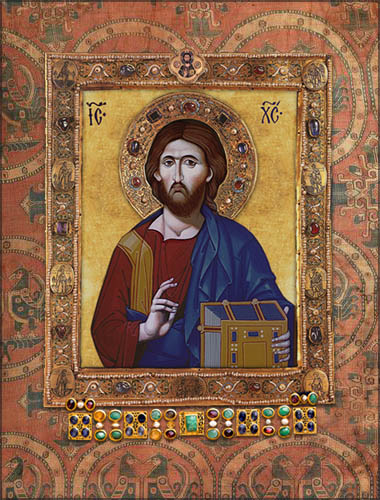


![]()




 click here for icons of christ
click here for icons of christ click here for icons of the theotokos
click here for icons of the theotokos click here for icons of angels
click here for icons of angels click here for icons of saints
click here for icons of saints